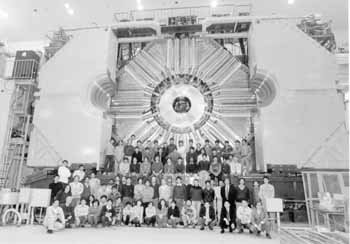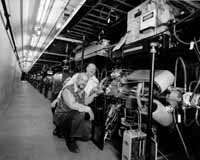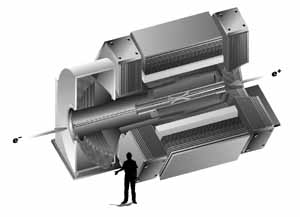 |
|
BaBar and Belle Hit the Big Time by Kurt Riesselmann BaBar and Belle took center stage recently in the long-running drama, "The Search for CP Violation." They showed why they are hot box-office draws in exploring the differences in behavior between matter and antimatter, as they reported their first results on July 31 at the International Conference on High Energy Physics in Osaka, Japan. Both BaBar, using electron-positron collisions at Stanford Linear Accelerator Center's Pep II collider, and Belle, also using electron-positron collisions at Japan's KEK laboratory, announced that their early data indicate signs of CP violation in B mesons, particles containing a bottom quark or anti- bottom quark. Their findings add luster to B physics as the next big show in CP violation, after 35 years in which the only show in town has been the kaon, a particle containing a strange or anti-strange quark. The BaBar and Belle findings show large statistical errors, but the experimenters know they'll have lots of chances to polish the script.
CP violation was postulated in the 1960s by the late Russian physicist Andrei Sakharov, seeking to explain why more matter than antimatter existed in the universe after the Big Bang. In 1964, recreating some of the particles that were abundant at the beginning of the universe, high-energy physicists James Cronin and Val Fitch observed CP violation in processes involving kaons, which brought them the Nobel Prize in 1980. Now physicists are on the verge of proving that B mesons, which are 10 times heavier than kaons, also exhibit CP violation. Early in 1999, the CDF collaboration at Fermilab made a splash with a significant observation in B mesons. The Fermilab production will continue when Collider Run II of the Tevatron begins in March 2001, with major upgrades in both the CDF and DZero detectors.
 They'll all be in pursuit of a measure for CP violation called sin2β (pronounced "sign two bayta"), the trigonometric function of a mixing angle whose value can range from ñ1 to 1. Experimental results obtained during the last three decades, together with theoretical calculations, suggest a Standard Model value of about 0.7. A direct measurement of sin2β had not been possible until recently. KEK physicists reported a result of 0.45, while experimenters at SLAC measured 0.12. However, both numbers have an uncertainty of about plus or minus 0.4, making conclusions premature. CDF, using proton-antiproton collisions, found a value of 0.79 for sin2β, with an uncertainty similar to the two recent measurements at SLAC and KEK. "The large and small numbers are not in serious disagreement," said David Hitlin, spokesman of the BaBar experiment. Eric Prebys, a physicist at Princeton University who is working on the Belle experiment, agreed. "Everything at the moment is consistent with each other," he said. Extending the CDF effort, collaborator Christoph Paus of the Massachusetts Institute of Technology is working with scientists from nine other institutions, building a system to measure the time of flight of particles produced in the CDF detector. The device will improve the B physics analyses at CDF, in general; and in particular, the measurement of the mass difference of two different states of B mesons that colliders at KEK and SLAC cannot produce. This mass difference also plays an important role in CP violation studies. "In Run I, which ended in 1996, the CDF detector triggered on B mesons using lepton production as a signal," Paus explained. "Starting next year, we will be able to trigger on events containing B mesons which decay into hadronic particles." Leptons, such as electrons and neutrinos, don't allow for a precise determination of the energy of the B mesons, since CDF and DZero cannot detect neutrinos. Looking for hadrons, which are particles containing quarks, is technically challenging, but leads to better results. Both CDF and DZero will be able to explore an area of CP violation that cannot be probed by BaBar and Belle: Bs mesons. These particles contain both bottom and strange quarks, and their production requires more energy than is the case for the usual B mesons. With both CDF and DZero upgrades focusing on Bs identification, Fermilab's experimental program will complement the B meson data obtained by BaBar and Belle. A third method of testing CP violation is pursued by Hera-B, a new detector at DESY, the German high-energy laboratory. It will identify Bs mesons created by smashing protons into a stationary target.
"Our theoretical understanding of CP violation is summarized by the so-called unitarity triangle," explained Ulrich Nierste, a postdoc of Fermilab's theory group. "Presently, there are four quantities that place constraints on the shape of the triangle, none of them very stringent. All B experiments aim at tightening the limits." Knowing two of the four quantities with great precision would be sufficient to uniquely fix the triangle. All additional information on the unitarity triangle then tests the correctness of the Standard Model. "Over the next few years we will see whether all constraints will merge and meet at the peak of the triangle," Nierste said. "If the results don't intersect, as could be the case for a small value of sin2β, experimenters will establish evidence for physics beyond the Standard Model. In that case, the Standard Model could even fail to correctly describe CP violation in the kaon system." If all quantities match up, the Standard Model would come out as the correct theoretical description. It would explain the breaking of matter-antimatter symmetry in both the kaon (strange quark) and B meson (bottom quark) sector. However, theorists have already realized that the overall magnitude of CP violation in the Standard Model is too small to explain the imbalance between matter and antimatter that must have occurred in the early universe. Clearly, the current description of nature's fundamental interactions is far from complete. "It's not just the discovery of a new particle that is important for particle physics and cosmology," said Hirotaka Sugawara, director general at KEK. In addition, the "[breaking of] symmetry is something we have to understand." With precision results just around the corner, BaBar and Belle may set the stage and provide the first look at physics beyond the Standard Model. B physics will hold the spotlight for years to come.
|
| last modified 8/25/2000 email Fermilab |
FRLsDFx9eyfrPXgV
 "We are encouraged that we will have some very good physics results by the end of our current run in October," said SLAC Director Jonathan Dorfan. Hiroaki Aihara, spokesman of the Belle collaboration, added that the Japanese collaboration would resume data taking in October and continue until the summer of 2001.
"We are encouraged that we will have some very good physics results by the end of our current run in October," said SLAC Director Jonathan Dorfan. Hiroaki Aihara, spokesman of the Belle collaboration, added that the Japanese collaboration would resume data taking in October and continue until the summer of 2001.
 "It's most gratifying to see how well the PEP II collider and the BaBar detector are working," added Dorfan, former project leader of the PEP II construction at SLAC. "Having been involved in the design, construction and commissioning, I can't tell you how pleased I am that the whole process has gone so smoothly. It's a real credit to two exceptional teams: The SLAC, LBNL and LLNL builders, commissioners and operators working on PEP II, and the nine-nation BaBar collaboration."
"It's most gratifying to see how well the PEP II collider and the BaBar detector are working," added Dorfan, former project leader of the PEP II construction at SLAC. "Having been involved in the design, construction and commissioning, I can't tell you how pleased I am that the whole process has gone so smoothly. It's a real credit to two exceptional teams: The SLAC, LBNL and LLNL builders, commissioners and operators working on PEP II, and the nine-nation BaBar collaboration."